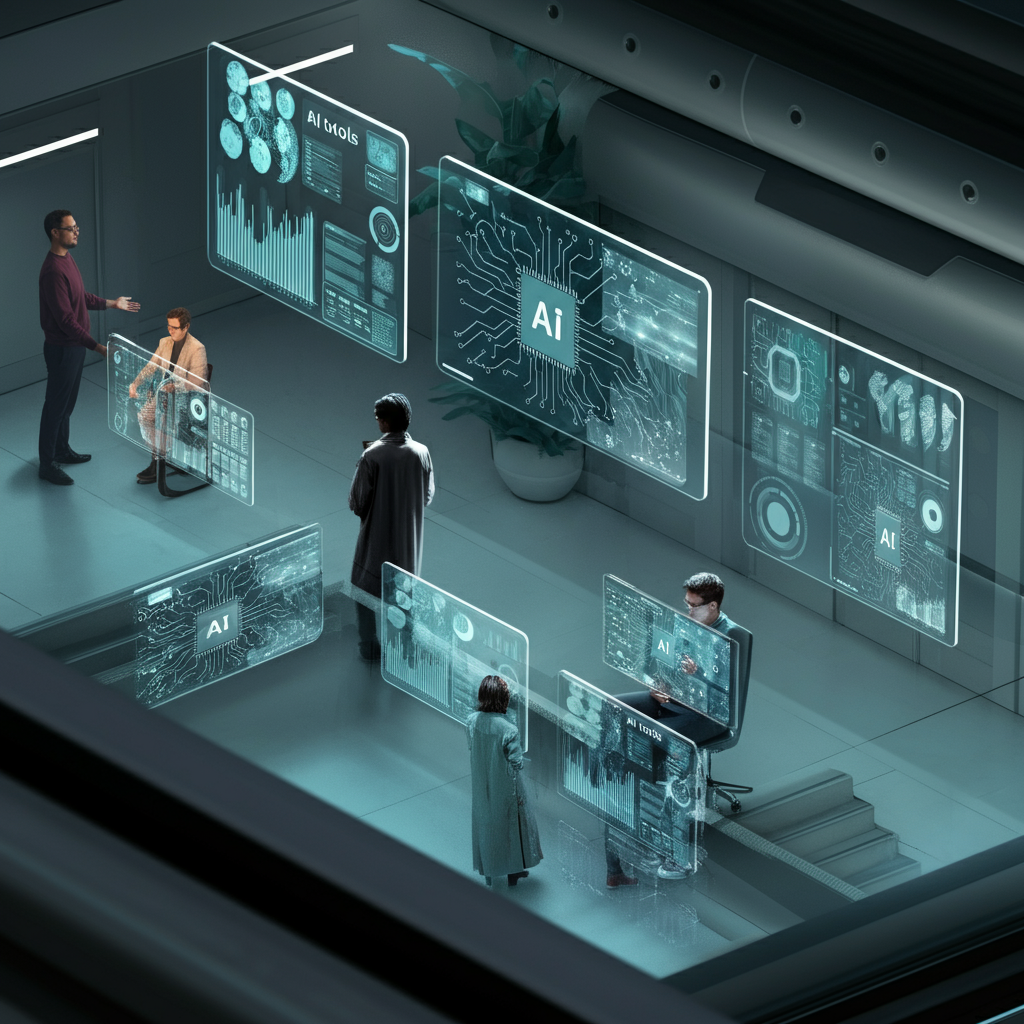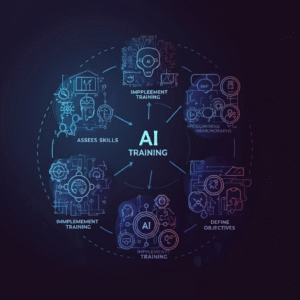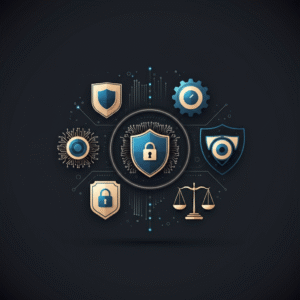
Introduction
Artificial intelligence is no longer a concept from science fiction; it’s a practical tool reshaping how businesses operate. However, investing in AI technology is only half the battle. The true value of AI is unlocked when your team knows how to use it effectively. Many organizations, especially small and medium-sized enterprises (SMEs), find that the biggest obstacle to successful AI integration isn’t the technology itself, but a significant skills gap within their workforce. Without proper team training for AI adoption, even the most advanced tools can sit unused, leading to wasted resources and missed opportunities.
This comprehensive guide will walk you through the essential steps to prepare your employees for AI tools. We will explore how to build a culture of AI readiness, design a tailored training program, and sustain momentum for long-term success. By turning employee hesitation into confident application, you can empower your workforce to leverage AI for greater efficiency, innovation, and growth. This is your roadmap for effective upskilling of staff for AI in SMEs and beyond.
Why Team Training for AI Adoption is Non-Negotiable
The rapid advancement of AI has created an urgent need for workforce education. Ignoring this can leave your business at a significant disadvantage. Effective team training for AI adoption is not just a ‘nice-to-have’—it’s a core component of a modern business strategy. Let’s explore the critical reasons why investing in your team’s AI skills is essential for survival and success.

Bridging the Critical Skills Gap
The gap between AI’s potential and the workforce’s ability to use it is widening. A recent Gartner survey highlighted that a lack of AI skills is the top barrier to AI implementation for 58% of business leaders. This isn’t just about technical expertise; it includes data literacy, critical thinking, and the ability to work alongside AI systems. Employee AI literacy training provides the foundational knowledge necessary for your team to understand what AI can and cannot do, enabling them to use these new tools responsibly and effectively. Without this bridge, your investment in technology will fail to deliver its promised returns.
Maximizing ROI and Building Confidence
Simply purchasing AI software doesn’t guarantee a return on investment. The real value comes from deep integration into daily workflows, which only happens when employees are confident and competent. When teams feel unprepared, they often revert to familiar, less efficient methods. AI adoption training for teams directly addresses this by demystifying the technology and providing hands-on experience. As employees see how AI can reduce repetitive tasks, generate insights, and free them up for more strategic work, their confidence grows. This positive reinforcement loop leads to higher adoption rates, improved productivity, and a tangible ROI.
Driving a Positive Culture Shift
One of the biggest hurdles in building AI readiness in the workplace is cultural resistance. Employees may feel threatened by AI, fearing their jobs are at risk. Others might be skeptical of its value or overwhelmed by the prospect of learning new systems. A well-structured training program proactively addresses these fears. By framing AI as a collaborative partner rather than a replacement, you can shift the narrative from anxiety to opportunity. Training helps employees understand the ‘why’ behind the change, showing them how AI aligns with the company’s vision and their personal growth. This fosters a culture of curiosity, innovation, and continuous learning, which is essential for any organization looking to thrive.
Laying the Groundwork: Preparing for an Effective AI Training Program
Before you can launch a successful training initiative, you need to set the stage. A rushed or poorly planned rollout can create more problems than it solves, leading to employee disengagement and wasted resources. Proper preparation involves building awareness, assessing your team’s current state, and defining what success looks like. This foundational work is crucial for designing a program that resonates with your team and delivers measurable business results.
Secure Leadership Buy-In and Build Awareness
Change starts at the top. Before you can expect your team to embrace AI, your leadership must be fully on board. Leadership endorsement sends a powerful message that team training for AI adoption is a strategic priority, not just another corporate initiative. Leaders should be able to articulate the vision: how will AI help the company achieve its goals? How will it make employees’ work more meaningful and less tedious?

Once leadership is aligned, focus on building awareness across the organization.
- Communicate the ‘Why’: Explain the business case for AI adoption in simple terms. Use town halls, newsletters, and team meetings to share success stories from other companies or highlight specific challenges AI can solve within your own.
- Demystify AI: Host introductory workshops that cover the basics of AI, machine learning, and generative AI. The goal is to make the topic approachable and dispel common myths or fears.
- Show, Don’t Just Tell: Provide simple demonstrations of AI tools in action. Seeing an AI assistant draft an email in seconds or summarize a long report can be a powerful motivator.
This initial phase is about creating a positive and informed environment where employees feel curious and open to change rather than defensive.
Assess Current AI Readiness and Skill Levels
You can’t create an effective training plan without knowing your starting point. A thorough assessment of your team’s current skills and attitudes towards AI is a critical step in building AI readiness in the workplace. This allows you to tailor the program to meet your employees where they are.
- Conduct Surveys and Assessments: Use anonymous surveys to gauge familiarity with AI concepts, current usage of AI tools (both personal and professional), and general sentiment. Ask about their perceived barriers and what they hope to gain from training.
- Hold One-on-One Interviews: For a deeper understanding, talk to key individuals and team leads. These conversations can reveal nuances that surveys might miss, such as specific workflow bottlenecks or hidden pockets of enthusiasm or resistance.
- Map Skills by Role: Recognize that AI’s impact will vary across departments. A marketing team might need training on generative AI for content creation, while an operations team might focus on AI for process automation. Create a simple map that links job roles to relevant AI applications and required skills.
This assessment provides the data you need to design a targeted and relevant training program, ensuring that you’re not delivering advanced content to beginners or basic information to those already familiar with the tools.
Define Clear and Measurable Training Objectives
A training program without clear objectives is like a journey without a destination. To ensure your efforts are focused and effective, you need to define what you want to achieve. These goals should be specific, measurable, and directly tied to business outcomes.
Instead of a vague goal like “improve AI skills,” set concrete objectives such as:
- “Enable the sales team to use AI for lead scoring, resulting in a 15% increase in qualified leads within three months.”
- “Train the customer support team to use an AI chatbot to resolve 30% of tier-one inquiries, freeing up agents for more complex issues.”
- “Equip the marketing team to generate first drafts of blog posts with AI, reducing content creation time by 25%.”
Linking your training objectives to tangible business metrics does two things. First, it clarifies the purpose of the training for employees, helping them see the direct value of their new skills. Second, it allows you to measure the success of your program and demonstrate its ROI to leadership, justifying further investment in upskilling staff for AI in SMEs and larger organizations alike.
Designing a High-Impact AI Training Program for Your Team
With the groundwork laid, it’s time to design the training program itself. A one-size-fits-all approach is destined to fail. The most effective AI adoption training for teams is customized, practical, and engaging. It acknowledges that different roles have different needs and that people learn best through a variety of methods. The goal is to create a learning journey that is not only informative but also empowering, giving employees the confidence to apply their new skills immediately.

Tailor Training to Specific Roles and Tools
Generic training is often perceived as irrelevant and quickly forgotten. To ensure engagement and application, your program must be tailored to the specific needs of different departments and roles.
- Role-Specific Modules: Develop training modules that focus on the use cases most relevant to each team. For instance, HR professionals could learn how to use AI to screen resumes and write job descriptions, while the finance team could explore AI for fraud detection and financial forecasting.
- Tool-Specific Workshops: Focus on the AI tools your organization has adopted or plans to adopt. If you’re implementing Microsoft Copilot, your training should center on its specific features and integration with Office 365. Training on abstract concepts is less effective than hands-on practice with the actual tools employees will use daily.
- Create Use-Case Libraries: Build a repository of practical examples, templates, and prompt libraries for different roles. A salesperson could benefit from a library of prompts for drafting follow-up emails, while a project manager might use templates for creating project timelines with an AI assistant.
This level of customization demonstrates that you respect your employees’ time and are committed to providing them with valuable, actionable knowledge.
Implement a Phased and Blended Learning Approach
Rolling out a new training program to the entire organization at once can be chaotic and ineffective. A phased approach allows you to test, refine, and build momentum. Combining different learning methods caters to diverse learning styles and schedules.
- Phase 1: Train the Champions: Start with a small group of enthusiastic employees and team leads. These “AI Champions” can become internal advocates and provide valuable feedback to refine the program.
- Phase 2: Pilot with Early Adopters: Expand the training to a department or team that is open to change and has clear use cases for AI. Document their successes and challenges to create case studies for the broader rollout.
- Phase 3: Full-Team Deployment: Armed with feedback, success stories, and trained champions, roll out the program to the rest of the organization.
Complement this phased rollout with a blended learning model:
- Live Workshops: For interactive, hands-on learning and team collaboration.
- Self-Paced Online Modules: For foundational knowledge and flexibility.
- Peer Learning Sessions: Encourage employees to share what they’ve learned and solve problems together.
- Hands-On Projects: The most critical component. Give employees real-world tasks to complete using AI.
Focus on Practical, Hands-On Learning
Theory is important, but skills are built through practice. The core of your training should be focused on applying AI to real-world tasks. This is the most effective way to prepare employees for AI tools.

Avoid long lectures on the history of neural networks. Instead, design sessions around practical activities:
- Drafting Communications: Have employees use an AI tool to draft emails, create meeting agendas, or write social media posts.
- Summarizing Information: Ask them to use AI to summarize a long article, a research report, or a meeting transcript.
- Brainstorming and Ideation: Use AI as a brainstorming partner to generate ideas for a new marketing campaign or a solution to a business problem.
- Data Analysis: Show them how to use AI to analyze a dataset and identify key trends or insights.
By integrating training directly into their daily work, you make learning immediately relevant and reinforce the habit of using AI as a go-to resource.
Address Ethics, Data Privacy, and Responsible Use
With great power comes great responsibility. An essential part of any employee AI literacy training is education on the ethical implications of using these powerful tools. Ignoring this can expose your organization to significant risks.

Your training must cover:
- Data Privacy and Security: Employees need to understand what information is safe to input into AI models and what is not. Sensitive company data, customer information, and proprietary code should never be shared with public AI tools.
- Bias and Accuracy: Train your team to be critical consumers of AI-generated content. AI models can inherit biases from their training data and sometimes produce inaccurate or misleading information (“hallucinations”). Employees must learn to fact-check and verify outputs.
- Intellectual Property: Discuss the legal and ethical considerations around using AI-generated content. Who owns the output? How can it be used commercially?
- Establish Clear Policies: Develop and communicate a clear AI usage policy that outlines the do’s and don’ts for your organization. This provides a framework for responsible experimentation and protects both the company and its employees.
Deploying and Sustaining Your AI Training Program
Launching a training program is just the beginning. The real challenge—and where many initiatives fail—is in sustaining momentum and embedding AI skills into the fabric of your organization. A one-time workshop will not create lasting change. You need a continuous ecosystem of support, reinforcement, and encouragement to foster a true culture of AI readiness in the workplace.
Launch with a Pilot and Build Momentum
Starting small is a powerful strategy. A pilot program allows you to test your training content, identify potential roadblocks, and gather success stories that can inspire the rest of the organization.
- Select the Right Pilot Group: Choose a team that is relatively tech-savvy, open to experimentation, and has clear, high-impact use cases for AI. Their success will serve as a powerful internal case study.
- Focus on a Specific Project: Give the pilot team a defined project with measurable goals. For example, task the marketing team with using AI to develop a content calendar and drafts for the next quarter.
- Document and Share Success: Track the pilot’s progress closely. Measure metrics like time saved, quality improvements, or new capabilities unlocked. Share these wins widely through internal communications. A testimonial from a colleague is often more persuasive than a directive from management.
These early wins create a ripple effect, building curiosity and reducing skepticism across other teams.
Provide Continuous Support and Resources
Learning doesn’t end when the workshop is over. To ensure skills are retained and applied, you must provide ongoing support. This creates a safety net for employees as they navigate the learning curve.
- Establish a Help Desk or Forum: Create a dedicated Slack channel, Teams group, or internal forum where employees can ask questions, share tips, and get help from AI Champions or IT staff.
- Offer Office Hours: Schedule regular “AI office hours” where experts are available to provide one-on-one coaching and troubleshoot problems.
- Build a Resource Hub: Maintain a centralized repository of training materials, including recorded webinars, FAQs, prompt libraries, and best-practice guides. Make it easy for employees to find the information they need when they need it.
- Follow-Up Sessions: Schedule brief follow-up sessions a few weeks after the initial training to reinforce key concepts, answer new questions, and share progress.
Monitor Progress and Celebrate Wins
What gets measured gets managed. Tracking progress is essential for understanding the impact of your team training for AI adoption and for keeping employees motivated.

- Track Key Metrics: Monitor both usage and impact. Track metrics like the number of employees actively using AI tools, the frequency of use, and the types of tasks being performed. Connect this to business outcomes like productivity gains, reduced costs, or faster project completion times.
- Recognize and Reward: Publicly acknowledge individuals and teams who are excelling in their use of AI. This could be through a shout-out in a company meeting, a small bonus, or an “AI Innovator of the Month” award.
- Celebrate Small Victories: Don’t wait for massive, game-changing results. Celebrate the small wins along the way. Did a team member save an hour by using AI to summarize meeting notes? Share that story! This makes progress feel tangible and encourages others to try.
Foster an AI-Use Habit
The ultimate goal is to make using AI a natural part of the daily workflow. This requires a conscious effort to build new habits.
- Encourage Micro-Tasks: Suggest small, daily or weekly challenges that encourage AI use. For example, “This week, try using AI to brainstorm three subject lines for your next email campaign.” These small, low-effort tasks help build muscle memory.
- Integrate into Existing Workflows: Make AI tools easily accessible from the platforms your team already uses. Seamless integration reduces friction and makes it more likely that employees will turn to AI for assistance.
- Lead by Example: Managers and leaders should visibly use AI in their own work and encourage their teams to do the same. When employees see their boss using AI to prepare for a meeting, it normalizes the behavior.
By actively deploying support systems and fostering daily habits, you can sustain the energy from your initial training and drive deep, lasting adoption.
Common Pitfalls in AI Training and How to Avoid Them
Even with the best intentions, team training for AI adoption can go off track. Being aware of common pitfalls can help you navigate the process more effectively and avoid costly mistakes. Proactively addressing these challenges will significantly increase your chances of a successful and impactful training program.
- Pitfall: Training is Too Generic: Rolling out a one-size-fits-all program often leads to disengagement because the content isn’t relevant to everyone’s daily job.
- Solution: Customize relentlessly. As discussed, segment your training by department and role. Work with team leads to identify the specific problems and tasks where AI can provide the most value for their teams. A tailored approach shows you understand and respect their unique workflows.
- Pitfall: Focusing Only on the Tool, Not the Mindset: Many programs teach the “how” (which buttons to click) but neglect the “why” and “when.” This results in employees who know how a tool works but don’t know how to think critically about applying it.
- Solution: Build transferable skills. Teach problem decomposition, prompt engineering, and critical evaluation of AI outputs. Encourage a mindset of “How can AI help with this?” rather than just following a rigid set of instructions. This empowers employees to adapt as tools evolve.
- Pitfall: A “Launch and Abandon” Mentality: A one-time training event without follow-up is a recipe for failure. Skills decay, questions arise, and old habits creep back in without ongoing support.
- Solution: Create a continuous support ecosystem. Implement the support structures mentioned earlier: help forums, office hours, and a resource hub. Treat training as an ongoing process, not a one-off event. Schedule regular check-ins and refresher courses.
- Pitfall: Ignoring Culture and Resistance: Forcing technology on a team that is fearful or skeptical will always be an uphill battle. Ignoring their concerns creates resentment and actively undermines adoption.
- Solution: Communicate transparently and involve teams early. Address fears head-on by being clear about how AI will augment, not replace, roles. Involve employees in the process of selecting tools and designing training. When people feel they have a voice, they are more likely to buy into the change.
- Pitfall: No Clear Metrics for Success: Without defined goals, you can’t measure whether your training is working. You won’t be able to justify the investment or know how to improve the program.
Solution: Define and track KPIs from the start. Link training objectives to concrete business outcomes (e.g., time saved, improved quality, increased output). Use a mix of usage data, performance metrics, and qualitative feedback to paint a full picture of the program’s impact.
By anticipating these common mistakes, you can design a more resilient and effective strategy for building AI readiness in the workplace, ensuring your investment in both technology and people pays off.
Conclusion: Your Workforce is Your Greatest AI Asset
The journey to successful AI integration is not paved with algorithms and servers alone; it is built by people. Effective team training for AI adoption is the critical link that transforms a powerful technology into a tangible business advantage. Without empowering your workforce with the right skills, confidence, and mindset, even the most sophisticated AI tools will fail to deliver on their promise.

By following a structured and people-centric approach—preparing your organization, designing customized and practical training, deploying it with robust support, and sustaining momentum over time—you can navigate this transformation successfully. This investment in employee AI literacy training does more than just close a skills gap; it fosters a culture of innovation, improves job satisfaction, and positions your organization to thrive in an increasingly AI-driven world.
The time to start is now. Begin by assessing your team’s readiness, securing leadership support, and defining what success looks like for your organization. By turning your employees into confident and capable AI users, you unlock their full potential and ensure that your greatest asset—your people—are leading your charge into the future.





Leave a Reply